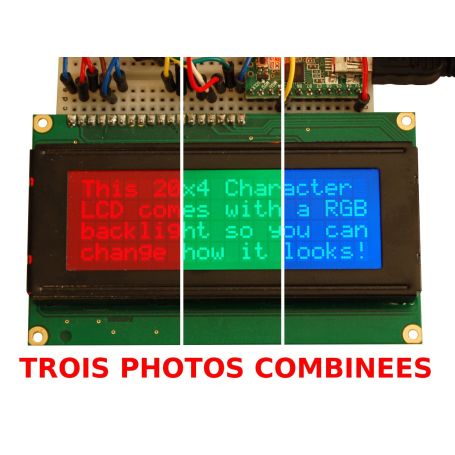LCD display 20x4 + EXTRA. RGB, negative display.
4 lines LCD display + extra
- 20 characters on each line
- Negative display
- RGB backlight
- Arduino & Raspberry ready
Payments are secured by LyraCollect, a French payment collection company.
It is possible to delivered to your home, to a pick-up point or picked up by appointment at MCHobby
We prepare, pack and ship your orders with great respect and care.
Using a 4 lines color LCD display with your project
This display is a nice upgrade from the standard 20x4 LCD displays. Instead of a blue on white or red on black display, this one offers a display of characters in color (optional, RGB palette) on a dark/black background! This means that you can change the color of the display characters at will - red, green, blue, pink, white, purple, yellow, bottle green, salmon, chartreuse, etc. This LCD is surprisingly good and efficient.
The really nice thing about this LCD is that it's a stylish upgrade but it can also be used with a standard LCD project and it will still work - only the red LED will be lit by a project. standard (so it is displayed as red on black). The two extra pins (17 and 18) are used for the green and blue LED. The LCD integrates the resistors which allows to drive the LEDs directly with 5V logic and the current is about 40mA per LED (it is actually two LEDs per color, 20mA each). The display uses a single point of illumination for the entire display, the image above shows a composite image displaying the three fundamental colors in a single photo!
Content
- A 20x4 display with RGB backlighting,
- A 10K potentiometer - needed for contrast adjustment,
- A section of pinHeader.
See the tutorial section for wiring and example code!
Technical details
- 20 characters on each line. 4 lines in total
- Text in color over dark/black background
- Single line 2.54mm wheelbase connection port (convenient for use with a breadboard or wired connection)
- The pin numbering is repeated on the back of the LCD.
- Backlighting based on an RGB LED (included) whose intensity can be easily controlled using a resistor or PWM.
This backlight requires less power than an electroluminescent (EL) backlight - Can be completely controlled using 6 digital pins!
Any digital/analog pin can be used and 3 PWM pins for backlight control. - English/Japanese character support, see HD44780 datasheet for more details on character set.
- Possibility to create up to 8 custom characters for creation of glyphs or support of accented characters
- Comes with a 10K potentiometer for contrast adjustment and a row of pinHeader
Technical details
- Display datasheet. Compatible with HD44780.
- Document detailling HD44780 commands (pdf)
Tutorials
- Tutorial detailled wiring (step by step) with Arduino (AdaFruit, english)
- Tutorial explaining own to wire the 16x2 LCD directly on a Raspberry PI (AdaFruit, English)
- Interface : Connector
- BREAKOUT
- Interface : Logic
- equal Vcc
- Interface : Vcc (power)
- 5V, 3V3









